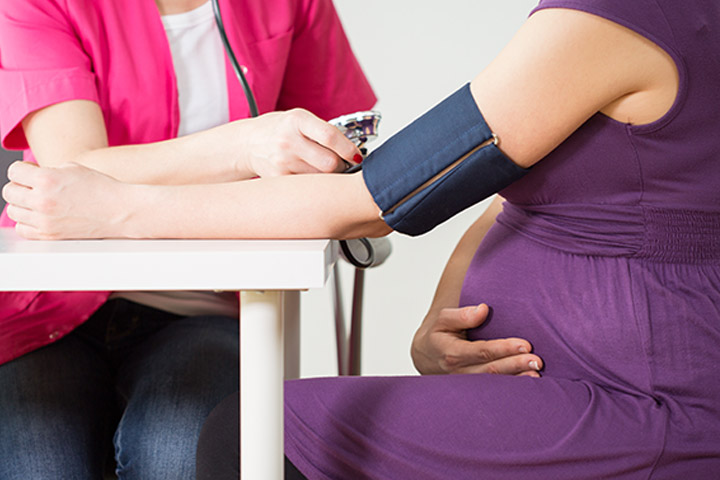Pre-Eclampsia is a term given to pregnancy specific hypertension with multi-system involvement.
- It is one of the leading causes of maternal and perinatal mortality and morbidity around the world.
- Hypertensive disorders of pregnancy affect about 10% of all pregnancies.
- Preeclampsia– eclampsia ranks second only to hemorrhage as a specific, direct cause of maternal death.
- The risk that a woman in a developing country will die of preeclampsia or eclampsia is about 300 times that of a woman in a developed country.
Hypertension during pregnancy can be categorized into 4 categories: This classification is proposed by the International Society for the Study of Hypertension in Pregnancy (ISSHP)
4 Types of Hypertension/Blood Pressure during Pregnancy
1. Preeclampsia – Eclampsia
Preeclampsia- Hypertension presenting beyond 20 weeks of gestation with [300 mg protein in a 24-h urine collection.
Eclampsia- Occurrence of seizures in a pregnant woman with pre-eclampsia. Eclampsia can occur before, during, or after labour.
2. Chronic Hypertension
Blood pressure 140/90 mmHg present before pregnancy, before the 20th week of gestation, or persisting beyond the 42nd postpartum day
3. Chronic Hypertension with Superimposed Pre-Eclampsia
The onset of features diagnostic of preeclampsia in a woman with chronic
hypertension beyond 20 weeks of gestation.
4. Gestational Hypertension
New onset elevation of blood pressure after 20 weeks of gestation, often near term, in the absence of proteinuria. Blood pressure returns to normal within 42nd postpartum day and is not associated with any other features of preeclampsia.
Classification of Pre-Eclampsia
Early onset pre-eclampsia (EOPET).
- Appearance of pre-eclampsia before 34 weeks
- Associated with greater morbidity and fourfold increased risk of stillbirth in a subsequent pregnancy, and higher recurrence risk in subsequent pregnancy than when the disorder presents later.
- The early onset disease may be associated with the underlying genetic or environmental factors leading to abnormal placentation.
Late onset preeclampsia (LO-PET)
- May be the result of obesity, diabetes, cardiovascular
abnormalities or multifetal pregnancy.
Atypical Preeclampsia
- Hypertension and proteinuria before 20 weeks
- Pre-eclampsia with hypertension but without proteinuria
- Preeclampsia with proteinuria without hypertension when associated with systemic involvement
- Preeclampsia arising first time after 48 h of delivery
Early Diagnosis of Preeclampsia
Specific inquiry of signs and symptoms mentioned below can help early diagnosis and reduce the adverse outcomes of preeclampsia.
- Weight gain (more than 600 g/week)
- Swelling of face or hands
- Headache that will not go away
- Seeing spots and changes in eyesight, blurred vision (Immediate attention needed as can be a sign of neurological defect)
- Malaise
- Nausea (prolonged or severe first-trimester emesis)
- Epigastric discomfort (may be mistaken as acidity)
- Right upper side discomfort
The Diagnosis of Pre-Eclampsia
When a previously normotensive pregnant woman has a persistently elevated blood pressure of 140 mm Hg systolic or higher or 90 mm Hg diastolic or higher that occurs after 20 weeks of gestation on 2 occasions 6 hours apart.
Proteinuria: ( 24 hour protein excretion equals or exceeds 300mg in 24 hours)
According to The American College of obstetrician and Gynecologists
– Proteinuria may not be present in Preeclamsia , especially in the presence of multisystem involvement.
– In the absence of proteinuria, Dignosis of Preeclamsia can be made on the following factors.
– Lower platelet count (<100000/ microliter)
– Impaired liver function test ( liver enzymes elevation twice the normal concentration
– New development of renal insufficiency ( elevated serum creatinine greater than 1.1 mg/dl) or doubling of serum creatinine in the absence of other renal disease)
– Pulmonary edema
– New onset cerebral or visual disturbances.
Risk Factors of High Blood Pressure in Pregnancy
Age: Women who are < 18 years old (Adolescent pregnancy) and those who are > 40 years old.
Pregnancy history: Multiparous women with a history of preeclampsia and women who are pregnant for the first time both are at increased risk of preeclampsia.
Obesity
Chronic hypertension or Chronic renal disease or both
Diabetes
Hyperplacentation and large placentas (e.g. twin pregnancy)
In vitro fertilization
Genetics: Women whose mother, sister, or half-sister had preeclampsia are at an increased risk for developing it during their own pregnancies.
Complications associated with Preeclampsia
- Eclampsia– Occurrence of generalized seizures in women with pre-eclampsia.
- HELLP syndrome (haemolysis, elevated liver enzymes and low platelet count)
Eclampsia and HELLP syndrome are important predictors of further organ dysfunctions and mortality .
- Maternal death ,Fetal growth restriction or fetal death
- Multiple system involvement: Headache, blurry vision, right upper quadrant pain, and low platelet count, clinical edema, acute renal failure
Long term sequle of Pre-Eclampsia
- Women with preeclampsia have a
three–four fold increased risk of developing chronic hypertension and an approximately two-fold increased risk of ischemic heart disease, stroke, and venous thromboem-bolism. - Fetal Effects: There is an increased risk of still births and neonatal death associated with preeclampsia. There is a twofold increased risk of neonatal mortality associated with preeclampsia. Baby born alive have increased risk of stroke, epilepsy and metabolic, nutritional and blood disease in later childhood or as an adult.
- Recurrence in Succeeding Pregnancies
Preeclampsia in previous pregnancy is an important risk factor for recurrence in the subsequent pregnancy
Prevention from High Blood Pressure in Pregnancy
1) Non pharmacological: daily bed rest, life-style changes, smoking, and regular prenatal exercise.
(2) Nutritional: higher total dietary fiber intake, dietary protein and energy, garlic, dietary sodium restriction, weight reduction, and fish oil supplementation.
(3) Pharmacological: vitamin D, magnesium, folic acid and other B-vitamins, zinc supplementation,
nitric oxide, progesterone, low-dose aspirin, low-dose aspirin/heparin, calcium supplementation, antihypertensive drugs, diuretics, antioxidant supplementation, and concomitant vitamin C and E supplementation.





